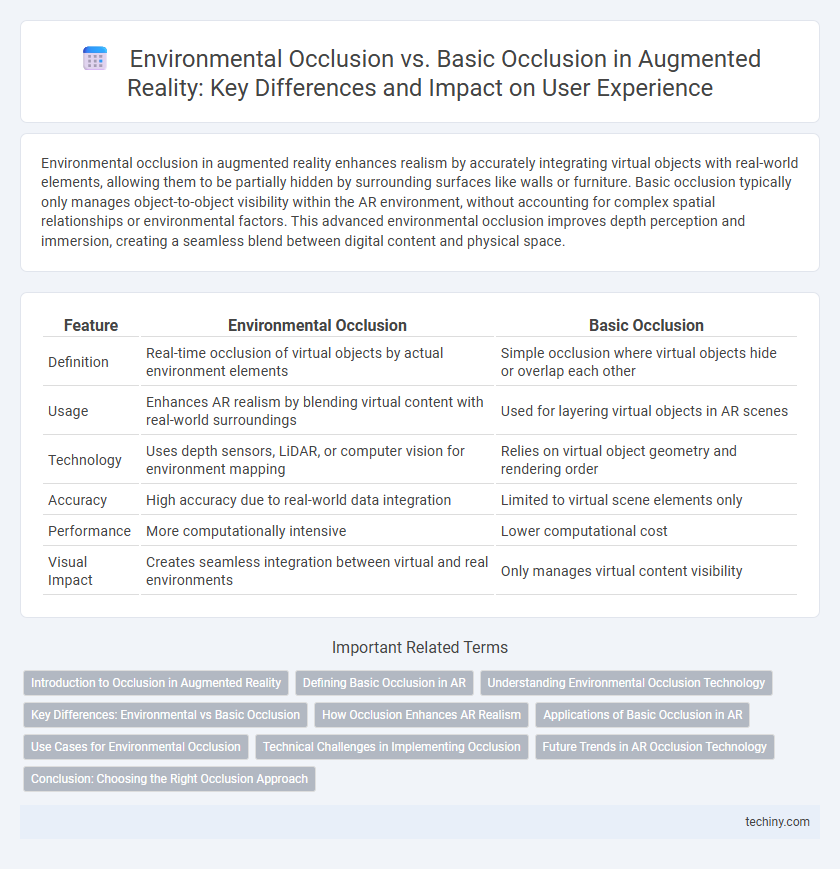Environmental occlusion in augmented reality enhances realism by accurately integrating virtual objects with real-world elements, allowing them to be partially hidden by surrounding surfaces like walls or furniture. Basic occlusion typically only manages object-to-object visibility within the AR environment, without accounting for complex spatial relationships or environmental factors. This advanced environmental occlusion improves depth perception and immersion, creating a seamless blend between digital content and physical space.
Table of Comparison
| Feature | Environmental Occlusion | Basic Occlusion |
|---|---|---|
| Definition | Real-time occlusion of virtual objects by actual environment elements | Simple occlusion where virtual objects hide or overlap each other |
| Usage | Enhances AR realism by blending virtual content with real-world surroundings | Used for layering virtual objects in AR scenes |
| Technology | Uses depth sensors, LiDAR, or computer vision for environment mapping | Relies on virtual object geometry and rendering order |
| Accuracy | High accuracy due to real-world data integration | Limited to virtual scene elements only |
| Performance | More computationally intensive | Lower computational cost |
| Visual Impact | Creates seamless integration between virtual and real environments | Only manages virtual content visibility |
Introduction to Occlusion in Augmented Reality
Environmental occlusion in augmented reality (AR) enhances realism by accurately layering virtual objects behind real-world elements based on depth and spatial mapping, unlike basic occlusion, which only uses simple depth cues to hide objects. Advanced sensors and AI algorithms enable environmental occlusion to interpret complex scenes and dynamically adjust object visibility, preserving natural interactions between virtual and physical environments. This technology significantly improves user immersion by preventing virtual objects from unrealistically overlaying or clipping through real-world surfaces.
Defining Basic Occlusion in AR
Basic occlusion in augmented reality refers to the simple blocking of virtual objects by real-world elements without accurately accounting for complex depth or environmental factors. It typically relies on fundamental depth sensing technologies that detect object placement relative to the user's viewpoint but may lack precision in dynamic or densely populated scenes. This form of occlusion helps establish spatial relationships but often results in less immersive AR experiences compared to environmental occlusion techniques.
Understanding Environmental Occlusion Technology
Environmental occlusion technology enhances augmented reality by accurately integrating virtual objects within real-world environments, allowing these objects to be partially obscured by physical elements like furniture or walls. Unlike basic occlusion, which simply hides virtual content behind flat surfaces, environmental occlusion utilizes advanced depth sensing and spatial mapping to create more realistic interactions between digital and physical objects. This technology significantly improves immersion and spatial awareness by ensuring virtual elements respond dynamically to environmental conditions and lighting.
Key Differences: Environmental vs Basic Occlusion
Environmental occlusion enhances augmented reality experiences by accurately blocking virtual objects behind real-world elements based on detailed spatial mapping and depth sensing, creating realistic interactions with complex environments. Basic occlusion relies on simpler, often planar or predefined masks that block virtual content without fully understanding the environment's geometry, resulting in less immersive and occasionally inconsistent visuals. Key differences include environmental occlusion's use of advanced sensor data for dynamic object integration versus basic occlusion's limited, static approach.
How Occlusion Enhances AR Realism
Environmental occlusion leverages real-world depth data and surface mapping to accurately block virtual objects behind physical elements, significantly enhancing AR realism by creating a seamless integration between digital and physical environments. Basic occlusion relies on simple layering techniques, which often result in virtual objects appearing unnaturally over or under physical items without true spatial awareness. By incorporating environmental occlusion, AR systems achieve more convincing spatial interactions, improving user immersion and the overall visual fidelity of augmented scenes.
Applications of Basic Occlusion in AR
Basic occlusion in augmented reality allows digital objects to be partially obscured by physical elements, enhancing the realism of AR experiences by aligning virtual content with real-world depth cues. Applications of basic occlusion include interactive gaming, where virtual characters appear behind real furniture, and industrial training, enabling precise overlay of instructions on complex machinery. This technique simplifies computational requirements while maintaining immersive engagement across mobile AR devices and smart glasses.
Use Cases for Environmental Occlusion
Environmental occlusion enhances augmented reality experiences by accurately integrating virtual objects within real-world scenes, allowing objects to be visually blocked by real environmental elements like furniture or walls, which basic occlusion cannot effectively achieve. Use cases include interior design applications where virtual furniture is seamlessly hidden behind real-world obstacles, urban planning tools that overlay models onto complex cityscapes, and industrial maintenance scenarios where virtual instructions interact naturally with physical machinery. This advanced occlusion technique significantly improves spatial awareness and user immersion in AR environments.
Technical Challenges in Implementing Occlusion
Environmental occlusion in augmented reality (AR) requires precise depth sensing and real-time processing to accurately mask virtual objects behind real-world elements, posing significant technical challenges such as managing dynamic lighting and complex environments. Basic occlusion, while simpler, often relies on pre-defined or static depth data, limiting realism due to inaccuracies in object overlap and depth perception. Implementing robust environmental occlusion demands advanced algorithms and high-fidelity sensors to handle occlusion consistently across diverse scenarios and device limitations.
Future Trends in AR Occlusion Technology
Future trends in AR occlusion technology emphasize advanced environmental occlusion, which improves realism by dynamically integrating virtual objects with complex real-world environments, including varied lighting and textures. Machine learning algorithms enhance scene understanding, enabling precise depth mapping and accurate layering of virtual content behind or within real objects. These innovations surpass basic occlusion methods, driving more immersive and seamless AR experiences across applications like gaming, architecture, and remote collaboration.
Conclusion: Choosing the Right Occlusion Approach
Selecting the right occlusion approach in augmented reality depends heavily on the desired realism and device capabilities. Environmental occlusion provides advanced depth perception by integrating dynamic real-world elements, enhancing user immersion but requiring more computational power. Basic occlusion offers simpler, less resource-intensive rendering suitable for devices with limited processing capacity or applications with minimal interaction between virtual and physical objects.
Environmental Occlusion vs Basic Occlusion Infographic

 techiny.com
techiny.com